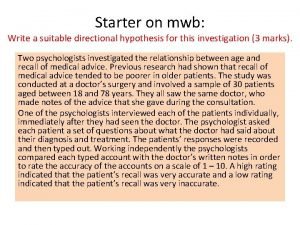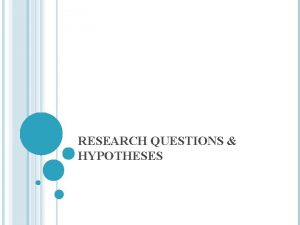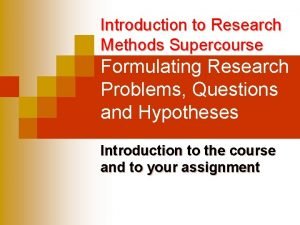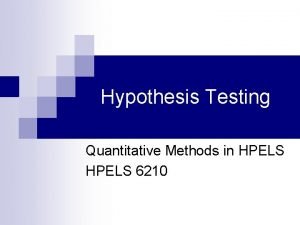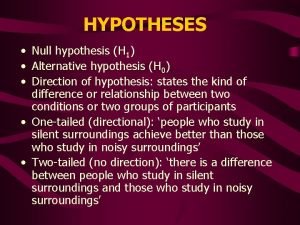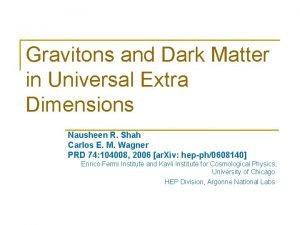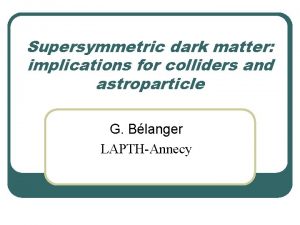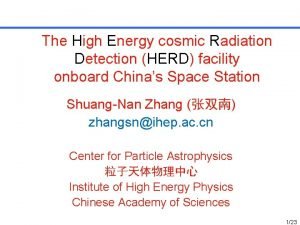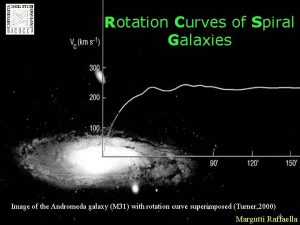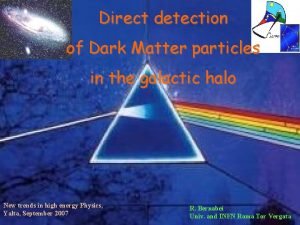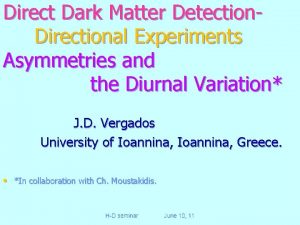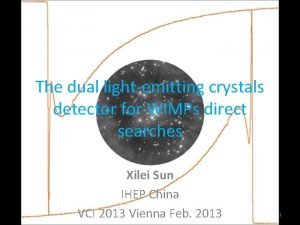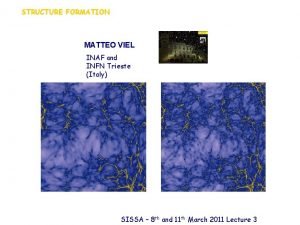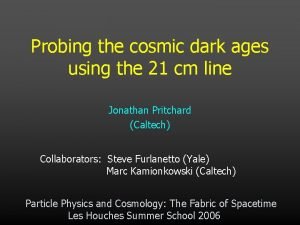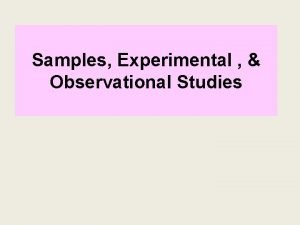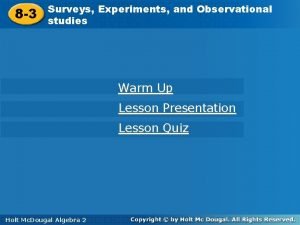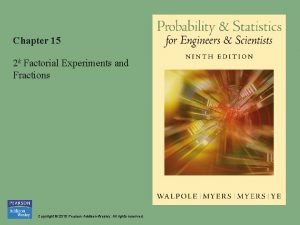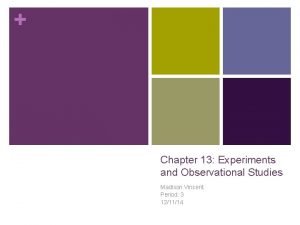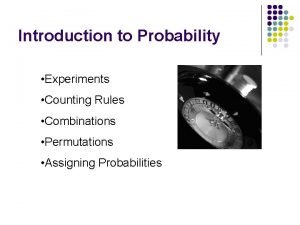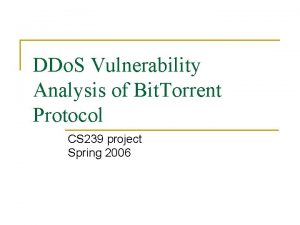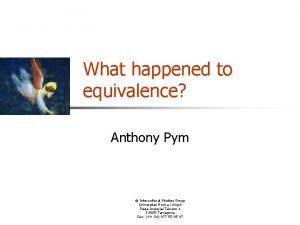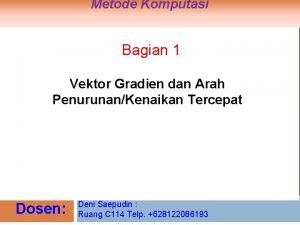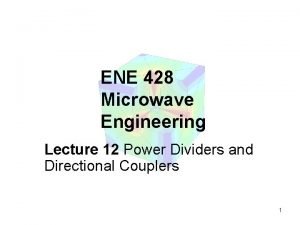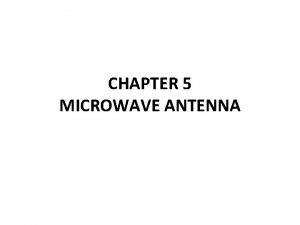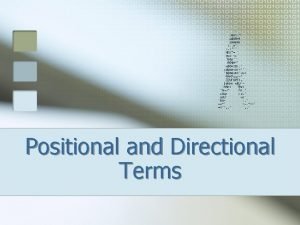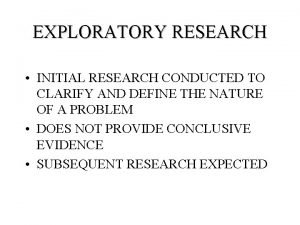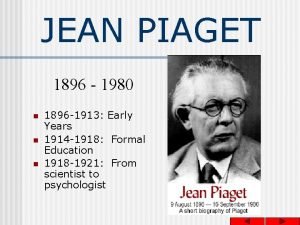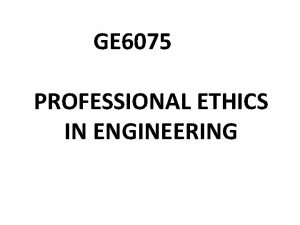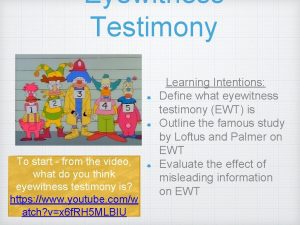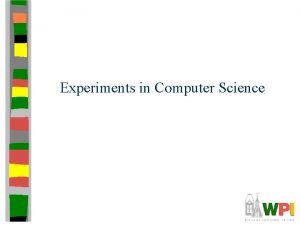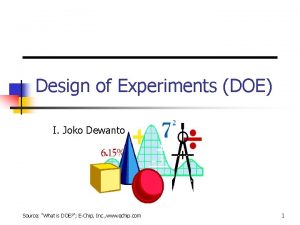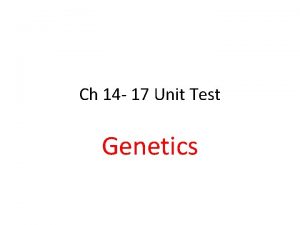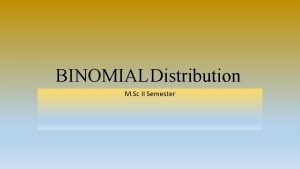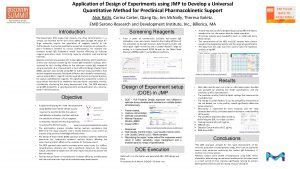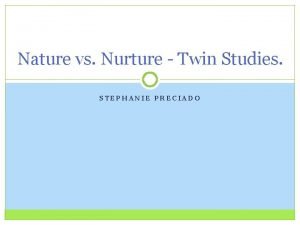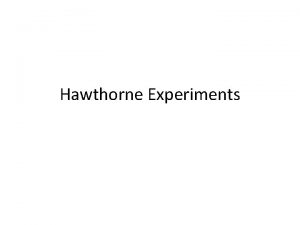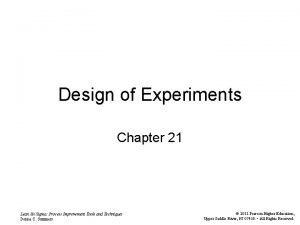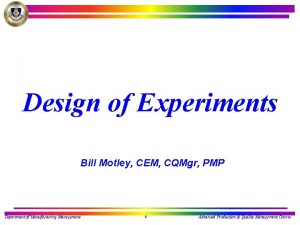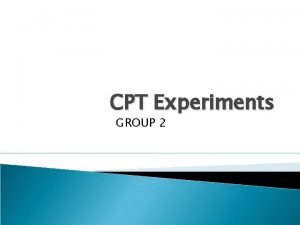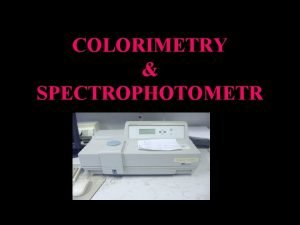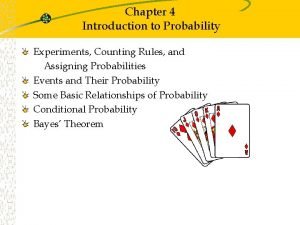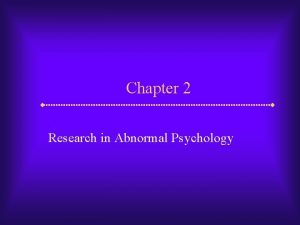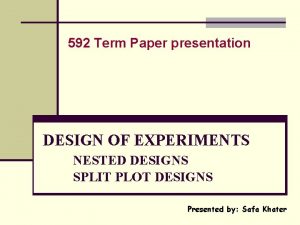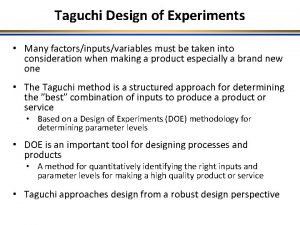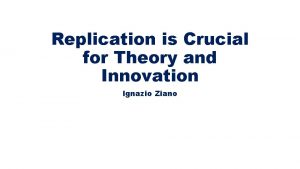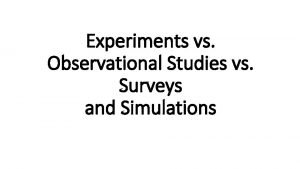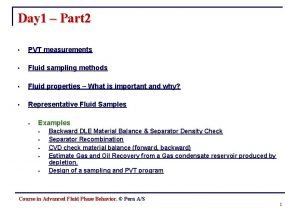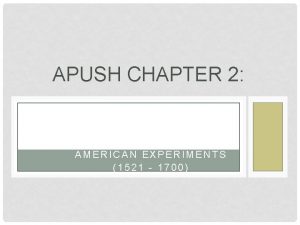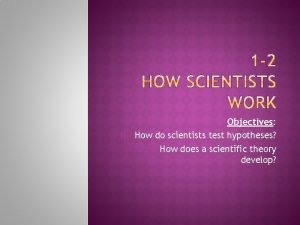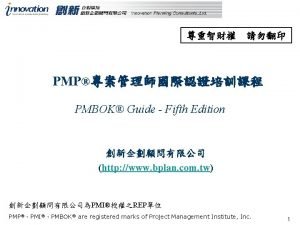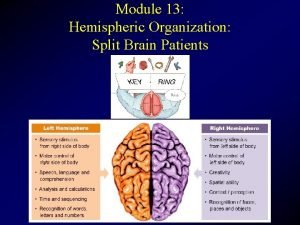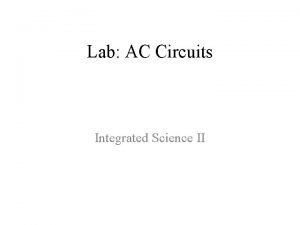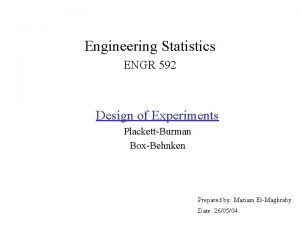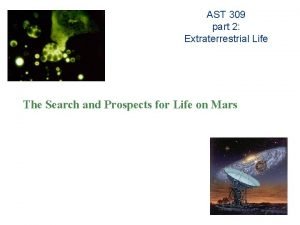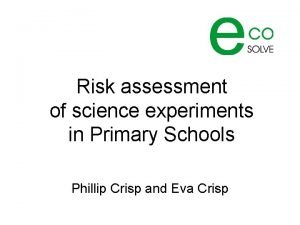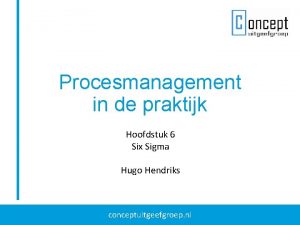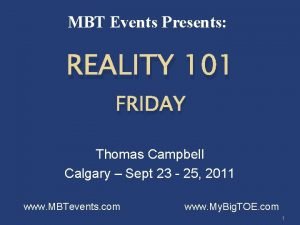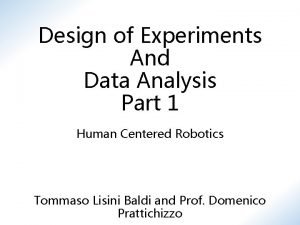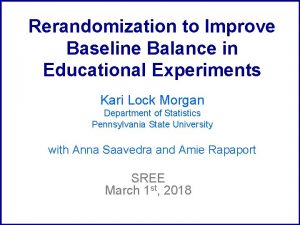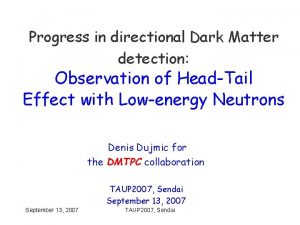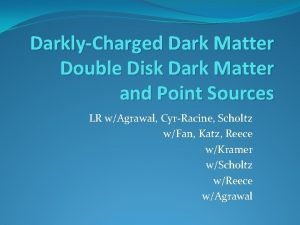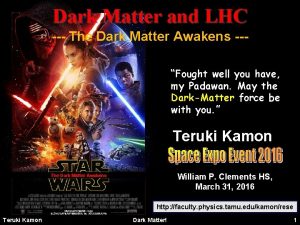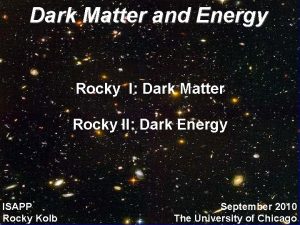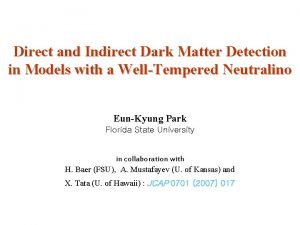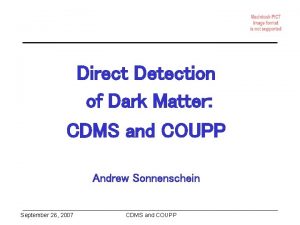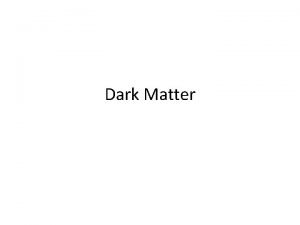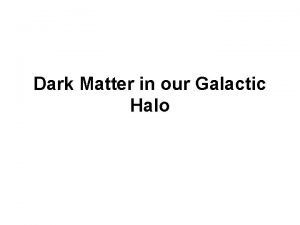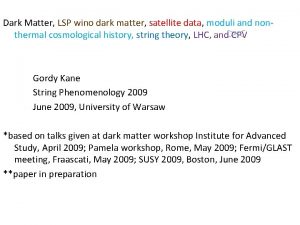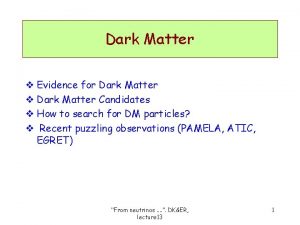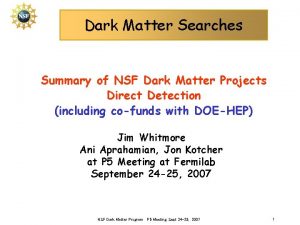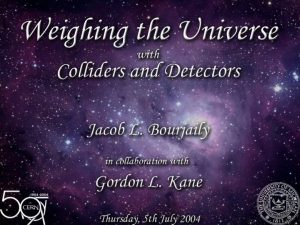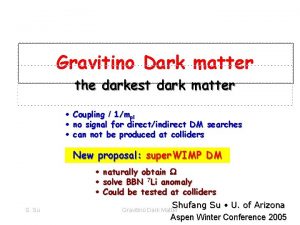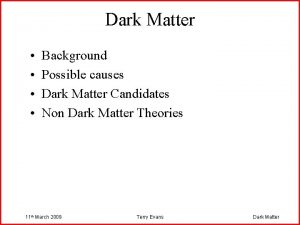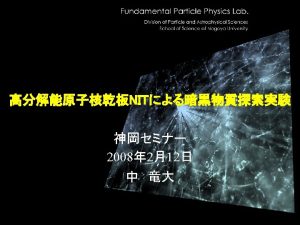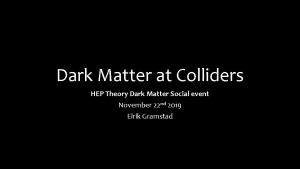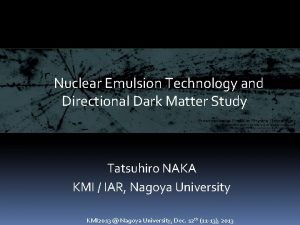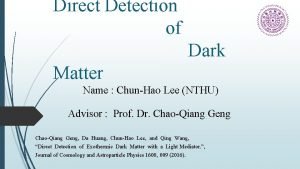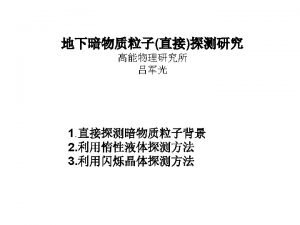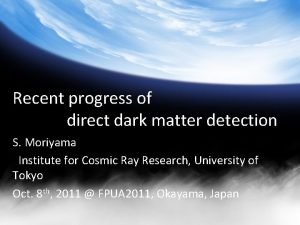Direct Dark Matter Detection Directional Experiments Asymmetries and































































































- Slides: 95

Direct Dark Matter Detection. Directional Experiments Asymmetries and the Diurnal Variation* J. D. Vergados University of Ioannina, Greece. • *In collaboration with Ch. Moustakidis. H-D seminar June 10, 11

EVIDENCE FOR THE EXISTENCE OF DARK MATTER • Gravitational effects around galaxies • Gravitational Lensing. The observation of the collision of two galaxy clusters (to-day 3. 5 109 ly away from us, 2 106 ly apart) • Cosmological Observations (confirmed by the recent WMAP 5 ; together with dark energy) H-D seminar June 10, 11

Slicing the Pie of the Cosmos WMAP 3: ΩCDM =0. 24± 0. 02, ΩΛ =0. 72± 0. 04, Ωb =0. 042± 0. 003 To-day (T=13. 6 billion y old) H-D seminar T=380000 y old June 10, 11

Dark Matter exists! What is the nature of dark matter? • • • It is not known. However: It possesses gravitational interactions (from the rotation curves) No other long range interaction is allowed. Otherwise it would have formed “atoms” and , hence, stars etc. So It is electrically neutral It does not interact strongly (if it did, it should have already been detected) It may (hopefully!) posses some very weak interaction This will depend on the assumed theory WIMPs (Weakly Interacting Massive Particles) Such an interaction may be exploited for its direct detection The smallness of the strength of such an interaction and its low energy makes its direct detection extremely difficult. So we have to seek for its special signatures, if any. H-D seminar June 10, 11

DARK MATTER (WIMP) CANDIDATES • The axion: 10 -6 e. V<ma <10 -3 e. V • The neutrino: It is not dominant. It is not cold, not CDM. • Supersymmetric particles. Four possibilities: • • • i) s-νετρίνο: Not favored on the basis of results of underground experiments and accelerator experiments (LEP) ii) Gravitino: Interesting possibility, but not directly detectable iii) Αxino: Interesting, but not directly detectable iv) A Majorana fermion, the neutralino or LSP (The lightest supersymmetric particle): A linear combination of the 2 neutral gauginos and the 2 neutral Higgsinos. MOST FAVORITE CANDIDATE! Particles from Universal Extra Dimension Theories (e. g. Kaluza. Klein WIMPs) The Lightest Technibaryon, LTB (Gudnason-Kouvaris-Sannino) Secluded Dark matter (to explain excess e+, e- in cosmic rays), Ioannina group (2009), T. Schwetz (2009)) H-D seminar June 10, 11

WIMP-Nucleus Elastic scattering H-D seminar June 10, 11

AI. The standard (non directional) event rate for the coherent mode • The number of events during time t is given by: Where: • tcoh , hcoh (modulation) depend on nuclear physics, the WIMP mass and the velocity distribution • ρ(0): the local WIMP density≈0. 3 Ge. V/cm 3. σSp, χ : the WIMP-nucleon cross section. It is computed in a particle model. It can be extracted from the data once fcoh (A, mχ) is known H-D seminar June 10, 11

AI 1: The coherent differential rate for σN =10 -7 pb and medium target (I or Ar) Q in ke. V H-D seminar June 10, 11

AI 2: The total Coherent Event Rate (σp, χ=10 -7 pb) (As a function of WIMP mass in Ge. V) Light System (F, S etc) H-D seminar Heavy System ( A=I, Xe etc) June 10, 11

EDELEEISS (Dr Eitel) XENON 100 (prl/2010 H-D seminar June 10, 11

AI 3: Threshold effect on event rates for a medium-heavy target vs WIMP mass Eth=10 ke. V (no quenching) H-D seminar Eth=10 ke. V (quenching) June 10, 11

AI 3: Threshold effect on event rates for a light target vs WIMP mass Eth=10 ke. V (no quenching) H-D seminar Eth=10 ke. V (quenching) June 10, 11

AII. WIMP-Nucleus scattering (both SI and SD); Modulation ignored H-D seminar June 10, 11

H-D seminar June 10, 11

Cross sections extracted from the rates R(127)=R(73)=1(kg-y)-1 Cannoni, Gomez and JDV, PRD 83(2011)075010 H-D seminar June 10, 11

Cross sections in a constrained MSSM Cannoni, Gomez and JDV, PRD 83(2011)075010 • A 0=0, μ>0 • m 0 <4000 Ge. V • m 1/2 <1500 Ge. V • Blue<->tanβ =10 • turquoise<->tan • β=50 Red: XENON 100 limit H-D seminar June 10, 11

Comparison of the cross sections Extracted Constrained MSSM H-D seminar June 10, 11

B: Novel approaches: Exploitation of other signatures of the reaction • The modulation effect: The seasonal, due to the • • motion of the Earth, dependence of the rate. Detection of other particles (electrons, X-rays), produced during the LSP-nucleus collision (it will not be discussed to-day). The excitation of the nucleus (in some cases : heavy WIMP, low excitation energy etc. ) and detection of the subsequently emitted de-excitation γ rays. (it will not be discussed to-day). • Asymmetry measurements in directional experiments (the direction of the recoiling nucleus must also be measured)--> • DIURNAL VARIATION. H-D seminar June 10, 11

BI: THE MODULATION EFFECT (standard recoil experiments) • • R=R 0 (1+h cosα) (total rate) d. R/d. Q=(d. R/d. Q)0+dh/d. Q cosα or d. R/d. Q=(d. R/d. Q)0 (1+H cosα ) (dif. Rate) (α is the phase of the Earth; α=0 around June 3 nd) h=modulation amplitude. R 0 =average rate. • The difference between the minimum and the maximum is 2 h or 2 H • The location of the maximum depends on the sign of h H-D seminar June 10, 11

BIa: The total modulation amplitude (As a function of WIMP mass in Ge. V) Light System (e. g. A=32, A=19) H-D seminar Heavy system (e. g. A=127) June 10, 11

BIb: The coherent differential mod. rate for σN =10 -7 pb and medium target (I or Ar) Q in ke. V H-D seminar June 10, 11

BIc: The relative (differential) Modulation amplitude (As a function of α for various WIMP mass in Ge. V) From left to right top to bottom: Q=2, 4. 6, 8 ke. V Heavy System (e. g. A=127, 131) H-D seminar Light system (e. g. A=F, Na) It is a bit smaller June 10, 11

BIc: The (differential) Modulation amplitude (As a function of α for various WIMP masses) for Na. I From left to right top to bottom : Q=2, 4. 6, 8 ke. V H-D seminar June 10, 11

BII: Directional Experiments* (Measuring both the energy and direction of the recoiling nucleus) • We will show that the observed events • will exhibit asymmetry due to the motion of the Sun • On top of this they will exhibit characteristic annual modulation due to the annual motion of the Earth • Both of these will manifest themselves as periodic diurnal variation due to the rotation of the Earth. • * DM-TPC, NEWAGE, DRIFT, MIMAC (Review: • S. Ahlen et al, ar. Xiv: 0911. 0323) *Also gaseous TPC detectors (3 -D reconstruction ar. Xiv: 1001. 2983 (atro-ph. CO) H-D seminar June 10, 11

WIMP flux, “The solar wind” (towards the Cygnus constellation), Spergel (88), vergados (02), Morgan-Green-Spooner (04). Flux variation Morgan-Green-Spooner (04). H-D seminar June 10, 11

BII: The directional event rate (The direction of recoil is observed) • The calculation will proceed in two steps: • A) Evaluation of the event rate as a function of (Θ, Φ) taking the sun’s direction of motion as polar axis (polar angle Θ) Φ is measured on a plane perpendicular to the sun’s velocity from x (radially out of the galaxy. The direction of recoil is - due to the Sun’s motion the rate depends only on Θ --> Asymmetry. -due to the Earth’s annual motion it will show a modulation, dependent on (Θ, Φ) with very characteristic signature. • B) The direction of observation fixed in the lab. -Then Diurnal variation due to the rotation of the Earth H-D seminar June 10, 11

Comparison of the usual (R) and directional (d. R/dΩ) total rates H-D seminar June 10, 11

Signatures in Directional Experiments -These experiments will attempt to measure both the energy and the direction of recoiling nucleus. - To simplify our discussion we will consider the rate in a given direction divided by the Standard rate - This will depend on • The WIMP Mass (the only particle parameter left). This will be treated as a free parameter • The velocity distribution of WIMP’s in our galaxy • The nuclear form factor BNL Seminar June 15/2009

The directional event rate (The direction of recoil is observed) • The event rate as a function of the direction angles (Θ, Φ) is: d. R/dΩ=(κ/2π)R 0[1+hmcos(α+α 0)], κ=t /tdir • R 0 is the average usual (non-dir) rate • α the phase of the Earth (as usual) • h m is the total modulation amplitude (it strongly depends on • • • the direction of observation): hmcos(α+α 0)=hccosα +hssinα α 0 is the shift in the phase of the Earth (it strongly depends on the direction of observation) κ/2π is the reduction factor (it depends on the direction of observation , but it is independent of the angle Φ). This factor becomes κ, after integrating over Φ. d. R/dΩ-> d. R/d(cosΘ) κ, hm and αm depend only slightly on the particle (e. g. SUSY) parameters and the reduced mass μr H-D seminar June 10, 11

The parameter κ vs Θ (Directional rates with Ch. Moustakidis) H-D seminar June 10, 11

The modulation amplitudes vs Φ for mχ =10 Ge. V for a light target For 19 F For 127Ι H-D seminar June 10, 11

The total modulation amplitude vs Φ for mχ =10 Ge. V for a light target The shift in the location The amplitude H-D seminar June 10, 11

Modulation vs the phase of the earth. H-D seminar June 10, 11

The modulation amplitudes vs Φ for mχ =10 Ge. V for a heavy target For 19 F For 127Ι H-D seminar June 10, 11

The total modulation amplitude vs Φ for mχ =10 Ge. V for a heavy target The amplitude The shift in phase H-D seminar June 10, 11

Modulation vs the phase of the earth. H-D seminar June 10, 11

The Diurnal variation of the rate in Directional Experiments • We have seen that: • the parameters κ and hm depend on the direction of • • observation relative to the sun’s velocity In a directional experiment the direction of observation is fixed with respect to the earth. Due to the rotation of the Earth during the day this direction points in different parts of the galactic sky. So the angles (Θ, Φ) change and the rate becomes time dependent. It will thus show a periodic behavior. H-D seminar June 10, 11

Schematic time dependence of the rate as may be seen in a directional experiment. Battat et al (IJMP A, 2009) H-D seminar June 10, 11

From the celestial (α=ascention, δ=inclination) to galactic coordinates H-D seminar June 10, 11

Diurnal Variation of the rate (κ) 19 F Target & Fully Directional WIMP MASS 10 Ge. V H-D seminar WIMP MASS 50 Ge. V June 10, 11

Diurnal Variation of the rate (κ) Iodine Target & Fully Directional WIMP MASS 10 Ge. V H-D seminar WIMP MASS 100 Ge. V June 10, 11

Diurnal Variation of the rate (κ) CS 2 Target& partly Directional WIMP MASS 10 Ge. V WIMP MASS 100 Ge. V H-D seminar June 10, 11

CONCLUSIONS: Non-directional • • • The modulation amplitude h : is small, less than 3%, and depends on the LSP mass. It depends on the velocity distribution Its sign is also uncertain. it is positive for light systems, but it may become negative for intermediate and heavy nuclei and heavy WIMPs (for both M-B and Realistic velocity distributions in the case of heavy WIMPS). Can this be exploited to extract the WIMP mass? It may increase as the energy threshold increases , but at the expense of the number of counts. It shows similar behavior in the case of the spin cross section. The DAMA experiment maybe consistent with the other experiments if the WIMP is very light or if the spin interaction dominates. Then their contour plot should move to larger nucleon cross sections (the spin proton cross section). H-D seminar June 10, 11

Prospects for exclusion plots (WIMP mass in Ge. V) H-D seminar June 10, 11

CONCLUSIONS: Non modulated rate in directional Experiments • A useful parameter is κ the reduction factor relative to the non • • directional rate κ strongly depends on the polar angle Θ ( the angle between the direction of observation and the sun’s velocity) κ≈1 in the most favored direction (Θ≈π in ΜΒ) As the Earth rotates the detector samples a different angle Θ-> The event rate (κ ) exhibits a periodic variation with a period of 24 hours. The form of the variation depends on the WIMP mass The amplitude of this variation depends on the inclination of the line of observation. It can be quite large. The variation persists, even if the sense of direction is not known. Then, however, the effect is smaller H-D seminar June 10, 11

CONCLUSIONS : The modulation in directional Experiments (preliminary) • The modulation amplitude in the most favored • • direction (κ≈1 ) is 0. 05<hm<0. 15 (bigger than in nondirectional case) depending on the WIMP mass. In plane perpendicular to the sun’s velocity (κ≈0. 3) hm is much bigger: | hm| ≈0. 25 (50% difference between maximum and minimum). Both its magnitude and its sign depend on the azymouthal angle Φ We are currently computing its time variation. Preliminary results show a weak but spectacular signal (it cannot be mimicked by other seasonal effects) H-D seminar June 10, 11

COMMON WISDOM! H-D seminar June 10, 11

• THE END H-D seminar June 10, 11

H-D seminar June 10, 11

Slicing the Pie of the Cosmos WMAP 3: ΩCDM =0. 24± 0. 02, ΩΛ =0. 72± 0. 04, Ωb =0. 042± 0. 003 H-D seminar June 10, 11

What I will say applies to: ALL DARK MATTER (WIMP) CANDIDATES • The axion: 10 -6 e. V<ma <10 -3 e. V • The neutrino: It is not dominant. It is not cold, not CDM. • Supersymmetric particles. Four possibilities: • • • i) s-νετρίνο: Excluded on the basis of results of underground experiments and accelerator experiments (LEP) ii) Gravitino: Interesting possibility, but not directly detectable iii) Αxino: Intersting, but not directly detectable iv) A Majorana fermion, the neutralino or LSP (The lightest supersymmetric particle): A linear combination of the 2 neutral gauginos and the 2 neutral Higgsinos. MOST FAVORITE CANDIDATE! Particles from Universal Extra Dimension Theories (e. g. Kaluza. Klein WIMPs) The Lightest Technibaryon, LTB (Gudnason-Kouvaris-Sannino) Secluded Dark matter (to explain excess e+, e- in cosmic rays) H-D seminar June 10, 11

Dark Matter exists! What is the nature of dark matter? • • • It is not known. However: It possesses gravitational interactions (from the rotation curves) No other long range interaction is allowed. Otherwise it would have formed “atoms” and , hence, stars etc. So It is electrically neutral It does not interact strongly (if it did, it should have already been detected) It may (hopefully!) posses some very weak interaction This will depend on the assumed theory WIMPs (Weakly Interacting Massive Particles) Such an interaction may be exploited for its direct detection The smallness of the strength of such an interaction and its low energy makes its direct detection extremely difficult. So we have to seek for its special signatures, if any. H-D seminar June 10, 11

NON RECOIL MEASUREMENTS • (a) Measurement of ionization electrons produced directly during the WIMPnucleus collisions • (b) Measurement of hard X-rays following the de-excitation of the atom in (a) • (c) Excitation of the Nucleus and observation of the de-excitation γ rays H-D seminar June 10, 11

Relative rate for electron ionization (there are Z electrons in an atom!) H-D seminar June 10, 11

Detection of hard X-rays • After the ionization there is a probability for a K • • or L hole This hole de-excites via emitting X-rays or Auger electrons. the fraction of X-rays per recoil is: σX(nℓ) /σr = bnl(σnℓ/σr) with σnℓ/σr the relative ionization rate per orbit and bnℓ the fluorescence ratio (determined experimentally) H-D seminar June 10, 11

The K X-ray BR in WIMP interactions in 132 Xe for masses: L 30 Ge. V, M 100 Ge. V, H 300 Ge. V H-D seminar June 10, 11

Excitation of the nucleus: The average WIMP energy is: • <Tχ>≈40 ke. V n 2 (mχ/100 Ge. V) • Tχ, max≈ 215 ke. V n 2 (mχ/100 Ge. V). Thus • mχ =500 Ge. V, n=2 <Tχ>≈0. 8 Me. V, Tχ, max≈ 4 Me. V • So excitation of the nucleus appears possible in exotic models with very heavy WIMPs H-D seminar June 10, 11

Unfortunately, Not all available energy is exploitable! • For ground to ground transitions (q momentum, Q energy) • For Transitions to excited states • Both are peaked around ξ=1 H-D seminar June 10, 11

The recoil energy in ke. V as a function of the WIMP velocity, in the case of A=127. Elastic scattering on the left and transitions to the Δ=50 ke. V excited state on the right. Shown for WIMP masses in the 100, 200, 500, 1000 and 1500 Ge. V. <ξβ>=10 -3 H-D seminar June 10, 11

The average nuclear recoil energy: A=127; Δ=50 ke. V (left), Δ=30 ke. V (right) H-D seminar June 10, 11

BR for transitions to the first excited state at 50 ke. V of I vs LSP mass (Ejiri; Quentin, Strottman and JDV) Relative to nucleon recoil. Quenching not included in the recoil i) Left Eth =0 ke. V ii) Right Eth =10 ke. V H-D seminar June 10, 11

Techniques for direct WIMP detection H-D seminar June 10, 11

Techniques for direct WIMP detection H-D seminar June 10, 11

Another view (Ap. PEC 19/10/06) Blue SUSY calculations (parameters on top) H-D seminar June 10, 11

A: Conversion of the energy of the recoiling nucleus into detectable form (light, heat, ionization etc. ) • The WIMP is non relativistic, < β>≈10 -3. • With few exceptions, it cannot excite the nucleus. It only scatters off elastically: • Measuring the energy of the recoiling nucleus is extremely hard: -Low event rate (much less than 10 per Kg of target per year are expected). -Bothersome backgrounds (the signal is not very characteristic). -Threshold effects. -Quenching factors. H-D seminar June 10, 11

If we could see Dark Matter H-D seminar June 10, 11

Slicing the Pie of the Cosmos WMAP 3: ΩCDM =0. 24± 0. 02, ΩΛ =0. 72± 0. 04, Ωb =0. 042± 0. 003 H-D seminar June 10, 11

The parameter κ vs the polar angle Θ in the case of A=32; mχ=10 Ge. V; Symmetric M-B definite sense Both senses H-D seminar June 10, 11

The parameter κ vs the polar angle Θ in the case of A=32; mχ=100 Ge. V definite sense Both senses H-D seminar June 10, 11

The parameter κ vs the polar angle Θ in the case of A=127; mχ=10 Ge. V definite sense Both senses H-D seminar June 10, 11

The parameter κ vs the polar angle Θ in the case of A=127; mχ=100 Ge. V definite sense Both senses H-D seminar June 10, 11

The parameter hm vs the polar angle Θ in the case of A=32; mχ=100 Ge. V One sense (Left), Both senses (Right) fine, thick, dashed <->Φ=(0, π/2, π) H-D seminar June 10, 11

The phase αm vs the polar angle in the case of A=32; mχ=100 Ge. V One sense (Left), Both senses (Right) H-D seminar June 10, 11

CONCLUSIONS: Electron production during LSP-nucleus collisions • During the neutralino-nucleus collisions, electrons may • • be kicked off the atom Electrons can be identified easier than nuclear recoils (Needed: low threshold (~0. 25 ke. V) TPC detectors) The branching ratio for this process depends on the atomic number, the threshold energies and the LSP mass. For a threshold energy of 0. 25 ke. V the ionization event rate in the case of a heavy target can exceed the rate for recoils by an order of magnitude. Detection of hard X-rays seams more feasible H-D seminar June 10, 11

Prelude : I. The standard (non directional) event rate for the coherent mode • The number of events during time t is given by: Where: • tcoh , hcoh (modulation) depend on nuclear physics, the WIMP mass and the velocity distribution • ρ(0): the local WIMP density≈0. 3 Ge. V/cm 3. σSp, χ : the WIMP-nucleon cross section. It is computed in a particle model. It can be extracted from the data once fcoh (A, mχ) is known H-D seminar June 10, 11

Ia: The Coherent Event Rate (σp, χ=10 -7 pb) (As a function of WIMP mass in Ge. V) Light System (e. g. A=32) H-D seminar Heavy System (e. g. A=131) June 10, 11

Ib: The time averaged event rate for a medium-heavy target vs WIMP mass Eth=10 ke. V (no quenching) H-D seminar Eth=10 ke. V (quenching) June 10, 11

Ic: The time averaged event rate for a light target vs WIMP mass Eth=10 ke. V (no quenching) H-D seminar Eth=10 ke. V (quenching) June 10, 11

Directional Experiments - To simplify our discussion we will consider the rate in a given direction divided by the Standard rate - This will depend on • The WIMP Mass (the only particle parameter needed). This will be treated as a free parameter • The velocity distribution of WIMP’s in our galaxy. We will employ the MB distribution. • The nuclear form factor H-D seminar June 10, 11

From the celestial to galactic coordinates H-D seminar June 10, 11

The circular path in the galactic system H-D seminar June 10, 11

III: The directional event rate (The direction of recoil is observed) • The calculation will proceed in two steps: • A) Evaluation of the event rate as a function of (Θ, Φ) taking the sun’s direction of motion as polar axis - due to the Sun’s motion the rate depends only on the polar angle Θ --> Asymmetry. -due to the Earth’s annual motion it will show a modulation dependent on (Θ, Φ) with very characteristic signature. Φ is measured on a plane perpendicular to the sun’s velocity from x (radially out of the galaxy) • B) The direction of observation fixed in the lab. -Then Diurnal variation due to the rotation of the Earth H-D seminar June 10, 11

The parameter κ vs the polar angle Θ (axial symmetry) in the case mχ=10 Ge. V; Red line: sun’s velocity Α=32 Α=131 H-D seminar June 10, 11

The parameter κ vs the polar angle Θ (axial symmetry) in the case mχ=30 Ge. V; Red line: sun’s velocity Α=131 Α=32 H-D seminar June 10, 11

The parameter κ vs the polar angle Θ (axial symmetry) in the case mχ=100 Ge. V; Red line: sun’s velocity Α=32 Α=131 H-D seminar June 10, 11

“The solar wind” (towards the Cygnus constallation) Spergel (88), vergados (02), Morgan-Green-Spooner (04). Courtesy of Morgan-Green-Spooner (04). H-D seminar June 10, 11

The parameter κ vs Θ for mχ=10 Ge. V(Directional rates with Ch. Moustakidis) For 32 s For 127Ι H-D seminar June 10, 11

Diurnal Variation of the rate (κ) Iodine Target & Fully Directional WIMP MASS 10 Ge. V H-D seminar WIMP MASS 50 Ge. V June 10, 11

Diurnal Variation of the rate (κ) Iodine Target & Fully Directional WIMP MASS 100 Ge. V H-D seminar WIMP MASS 200 Ge. V June 10, 11

The rate depends on Θ. Θ depends on time due to the earth’s rotation H-D seminar June 10, 11

Diurnal Variation of the rate (κ) Iodine Target& partly Directional WIMP MASS 10 Ge. V WIMP MASS 100 Ge. V H-D seminar June 10, 11

Modulation vs the phase of the earth. H-D seminar June 10, 11

Modulation vs the phase of the earth. H-D seminar June 10, 11

The Next step is to use realistic Asymmetric Velocity Distribution • Obtained from Realistic Density Profiles In the Eddington Approach • The asymmetry parameter β is linked to the angular momentum of DM fluid • It can be fitted to an Axially Symmetric M-B Velocity Distribution H-D seminar June 10, 11

Velocity distribution obtained in the Eddington approach NFW Halo Density profile H-D seminar Axially symmetric M-B June 10, 11
 Dark matter and dark energy ppt
Dark matter and dark energy ppt Directional hypothesis example
Directional hypothesis example General problem in research example
General problem in research example Directional and non directional hypothesis
Directional and non directional hypothesis Directional and non directional hypothesis
Directional and non directional hypothesis What is directional and non directional hypothesis
What is directional and non directional hypothesis Directional and non directional hypothesis
Directional and non directional hypothesis Directional hypothesis example
Directional hypothesis example In the dark dark town
In the dark dark town Dark matter gravitons dimensions
Dark matter gravitons dimensions Boosted dark matter
Boosted dark matter Dark matter
Dark matter Dark matter pwo
Dark matter pwo Dark matter physics
Dark matter physics Where to stream dark matter
Where to stream dark matter What could dark matter be
What could dark matter be Dark matter
Dark matter Matteo viel
Matteo viel Dark matter
Dark matter Les houches dark matter
Les houches dark matter Gray matter
Gray matter Brain falx
Brain falx Gray matter and white matter
Gray matter and white matter Matter
Matter Classification of matter section 1 composition of matter
Classification of matter section 1 composition of matter Classification of matter section 1 composition of matter
Classification of matter section 1 composition of matter Chapter 2 matter section 1 classifying matter answer key
Chapter 2 matter section 1 classifying matter answer key Composition of matter section 1
Composition of matter section 1 Flow of energy vs flow of matter
Flow of energy vs flow of matter Observational study vs experiment worksheet
Observational study vs experiment worksheet Survey experiment or observational study
Survey experiment or observational study 2k factorial experiments and fractions
2k factorial experiments and fractions Chapter 13 experiments and observational studies
Chapter 13 experiments and observational studies Miller and urey's experiments attempted to demonstrate
Miller and urey's experiments attempted to demonstrate Counting rules in probability
Counting rules in probability Pros cons animal testing
Pros cons animal testing Ddo vulnerability
Ddo vulnerability Pym equivalence
Pym equivalence Turunan berarah
Turunan berarah Power dividers and directional couplers
Power dividers and directional couplers Body parts in anatomical position
Body parts in anatomical position Microwave antenna types
Microwave antenna types Positional and directional terms
Positional and directional terms Hyperextension
Hyperextension Body directional terms
Body directional terms Stabilizing selection
Stabilizing selection Exploratory research disadvantages
Exploratory research disadvantages Positional and directional terms
Positional and directional terms Http://earthobservatory.nasa.gov/experiments/biome/
Http://earthobservatory.nasa.gov/experiments/biome/ M&m experiments with scientific method
M&m experiments with scientific method 1980-1896
1980-1896 A balanced outlook on law
A balanced outlook on law Science experiments for highschool
Science experiments for highschool Eyewitness testimony video experiments
Eyewitness testimony video experiments Computer science experiments
Computer science experiments Czech experiments
Czech experiments Griffith
Griffith Design of experiments doe
Design of experiments doe In his transformation experiments what did griffith observe
In his transformation experiments what did griffith observe Which three criteria do binomial experiments meet?
Which three criteria do binomial experiments meet? Jmp design of experiments
Jmp design of experiments Examples of binomial experiments
Examples of binomial experiments Computer organization lab experiments
Computer organization lab experiments Margaret floy washburn approach to psychology
Margaret floy washburn approach to psychology Daphne goodship and barbara herbert
Daphne goodship and barbara herbert Leaving cert construction studies
Leaving cert construction studies Core flooding experiments
Core flooding experiments Hawthorne experiments were conducted by
Hawthorne experiments were conducted by Design of experiments six sigma
Design of experiments six sigma Design of experiments quality management pmp
Design of experiments quality management pmp Experiments in goodness
Experiments in goodness Colorimetry experiments
Colorimetry experiments Counting rule for multiple-step experiments
Counting rule for multiple-step experiments Abnormal psychology experiments
Abnormal psychology experiments Paper presentation design
Paper presentation design Worked out
Worked out Why is “replication key” psychology experiments?
Why is “replication key” psychology experiments? If acid is splashed on your skin, wash at once with *
If acid is splashed on your skin, wash at once with * Difference between observational and experimental study
Difference between observational and experimental study Pvt sample
Pvt sample Chattel slavery apush
Chattel slavery apush How do scientist test hypothesis? *
How do scientist test hypothesis? * Design of experiments pmp
Design of experiments pmp Liz sneddon experiments
Liz sneddon experiments Split brain experiments
Split brain experiments Investigating conductors lab report
Investigating conductors lab report Plackett burman method
Plackett burman method Viking experiments
Viking experiments Checklist for good practices in laboratory experiments
Checklist for good practices in laboratory experiments Science experiment risk assessment
Science experiment risk assessment Design of experiments voorbeeld
Design of experiments voorbeeld Tom campbell virtual reality
Tom campbell virtual reality Design of experiments
Design of experiments Rerandomization to improve covariate balance in experiments
Rerandomization to improve covariate balance in experiments Radial heat conduction lab report
Radial heat conduction lab report What are mendel's three laws of inheritance
What are mendel's three laws of inheritance

